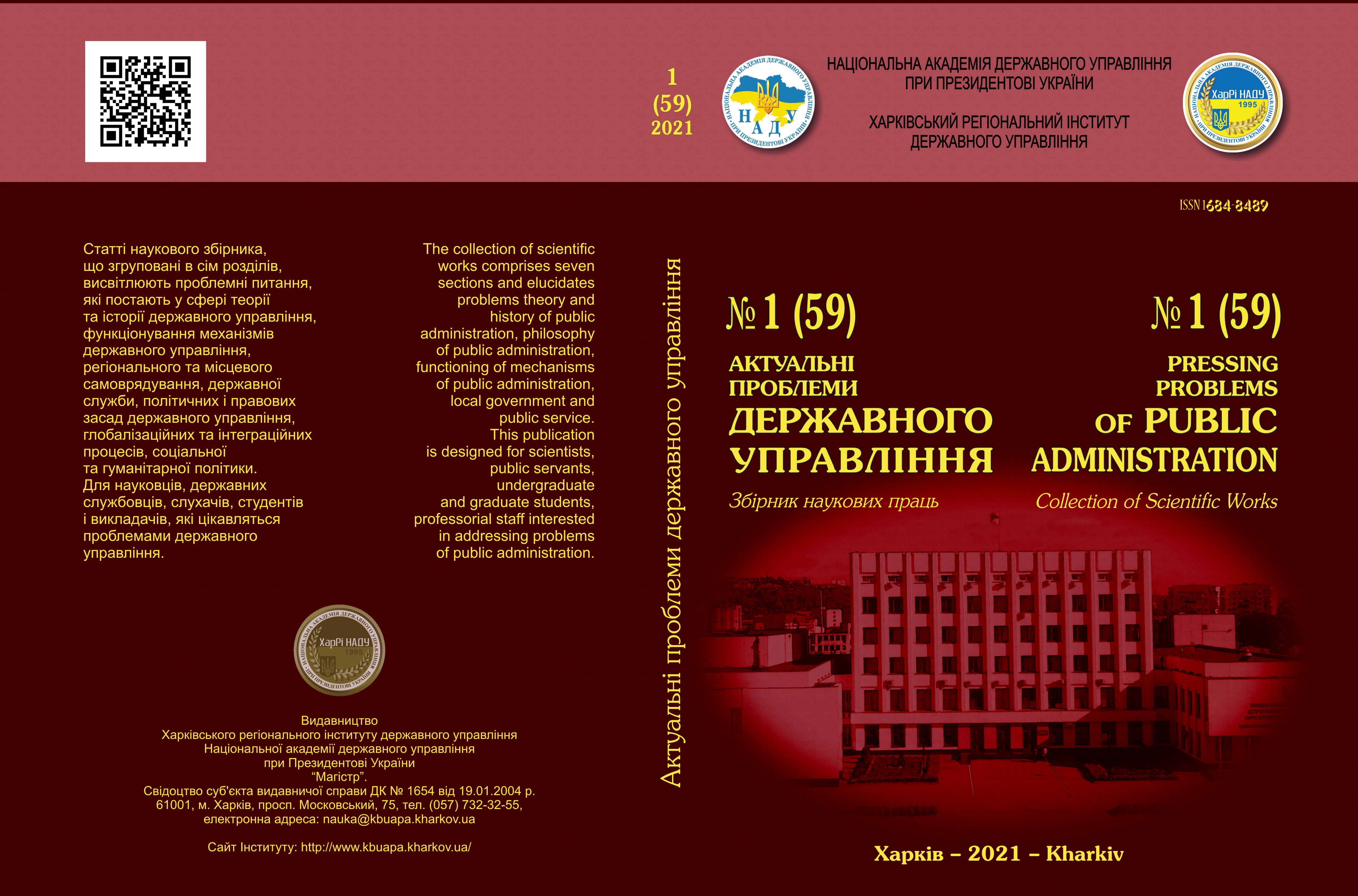ФОРМУВАННЯ СУСПІЛЬНОЇ ЦІННОСТІ НА ОСНОВІ НАЯВНИХ ПЛАТФОРМНИХ РІШЕНЬ У ПУБЛІЧНОМУ СЕКТОРІ
Анотація
Обґрунтовано напрями та зміст прирощення суспільної цінності завдяки запровадженню децентралізованих інформаційних платформ у межах наявної моделі GaaP, що реалізована на державних централізованих платформах. Проаналізовано діяльності найбільш резонансних і знакових іноземних державних централізованих платформ із Британії, Індії, Естонії, Італії та України. На їхньому прикладі простежується технологічний спосіб формування нової суспільної цінності завдяки застосуванню трьох головних механізмів налагодження бізнес-процесів. Порівнюючи з наявною практикою роботи централізованих платформ, запропоновано новий зміст прирощення суспільної цінності завдяки запровадженню децентралізованих інформаційних платформ. Зроблено висновок, що попри сьогоднішній скепсис урядів до інтеграції державних баз даних із реєстрами на блокчейні, така інтеграція є дуже ймовірною вже у перспективі 2–3 років, що стане можливим завдяки запровадженню нових веб-модулів і визнанню довірених приватних реєстрів на блокчейні.
Завантаження
Посилання
Gosudarstvo kak platforma: Lyudi i tekhnologii. (2019). M.S. Shklyaruk (Ed.). Moscow: RANKhiGS [in Russian].
Dunaiev, I.V. (2020). Yak stymuliuvaty ekonomichne zrostannia v Ukraini? Alternatyvni mozhlyvosti vid tsyfrovoi ekonomiky cherez poiasnennia teoremy Kouza. Publichne upravlinnia KhKhI stolittia: portal mozhlyvostei: zb. tez XKh Mizhnar. nauk. konhresu. Kharkiv: Vyd-vo KharRI NADU “Mahistr”, 277–280 [in Ukrainian].
Kud, A.A. (2021). Detsentralizovani informatsiini platformy yak instrument modernizatsii publichnoho upravlinnia. Visnyk pisliadyplomnoi osvity. Seriia “Upravlinnia ta administruvannia”, 1, issue 15 (44),233–274 [in Ukrainian].
Pelts, K. (2004). Orkestrovka i khoreografiya Web-servisov. URL: www.osp.ru/os/2004/11/184785 [in Russian].
Poiasniuvalna zapyska vid 10.09.2019 r. do proektu Zakonu Ukrainy “Pro publichni elektronni reiestry” № 2110 vid 10.09.2019 r. (2019). URL: http://w1.c1.rada.gov.ua/pls/zweb2/webproc4_1?pf3511=66772 [in Ukrainian].
Pro Natsionalnu veb-platformu tsentriv nadannia administratyvnykh posluh : Postanova Kabinetu Ministriv Ukrainy vid 03.02.2021 r. № 72. (2021). URL: https://zakon.rada.gov.ua/laws/show/72-2021-%D0%BF#Text.
Baldwin, C.Y., Woodard, J. (2008). The Architecture of Platforms: A Unified View. Working Papers. Harvard Business School Division of Research, 1–31. URL: http://search.ebscohost.com/login.aspx?direct=true&db=bth&AN=43456319&site= ehost-live.
Benington, J., Moore, M. H. (2010). Public Value: Theory and Practice. Palgrave Macmillan
Bozeman, B. (2007). Public Values and Public Interest: Counterbalancing Economic Individualism. Washington, D.C.: Georgetown University Press.
Brown, A., Fishenden, J., Thompson, M. (2014). Digitizing Government: Understanding and Implementing New Digital Business Models. Houndmills, Basingstoke, Hampshire; New York, NY: Palgrave Macmillan.
Brown, A., Fishenden, J., Thompson, M., Venters, W. (2017). Appraising the impact and role of platform models and Government as a Platform (GaaP) in UK Government public service reform: Towards a Platform Assessment Framework (PAF). Government Information Quarterly, 34(2, 167–182.
Cordella, A., Paletti, A. (2019). Government as a platform, orchestration, and public value creation: The Italian case. Government Information Quarterly.
Cordella. A., Paletti. A. (2018). ICTs and value creation in public sector: Manufacturing logic vs service logic. Information Polity, 23(2).
Eaton, B., Elaluf-Calderwood, S., Sørensen, C., Yoo, Y. (2015). Distributed Tuning of Boundary Resources: The Case of Apple’s iOS Service System. MIS Quarterly, 7.
Government as a platform: 2018 GaaP Readiness Index. Accenture. Philadelphia: Accenture. (2018). URL: https://www.accenture.com/_acnmedia/PDF-83/Accenture-GaaP-2018-Readiness-Index.pdf.
Janssen, M., Estevez, E. (2011). Lean government and platform-based governance – Doing more with less. Government Information Quarterly, 30, S1–S8.
Kud, A. (2019). Substantiation of the Term “Digital Asset”: Economic and Legal Aspects. International Journal of Education and Science, vol. 2, 1, 41–52. URL: http://culturehealth.org/ijes_archive/IJES,Vol.2,No1,2019_(6).pdf.
Kud, A. (2020). The Phenomenon of Virtual Assets: Economic and Legal Aspects. International Journal of Education and Science, vol. 3, 3, 13–24. URL: https://culturehealth.org/ijes_archive/IJES.2020.4.2.pdf.
Moore, M. (1995). Creating Public Value: Strategic Management in Government. Harvard University Press.
O’Reilly, T. (2011). Government as a Platform. Innovations, MIT Press, 6 (1). 13–40.
Page, S., Stone, M., Bryson, J., & Crosby, B. (2015). Public value creation by cross-sector collaborations: A framework and challenges of assessment. Public Administration, 93 (3), 715–732.
People, Power and Technology: The 2018 Digital Attitudes Report. Doteveryone. London: Doteveryone. (2018). URL: https://doteveryone.org.uk/wp-content/uploads/2018/06/People-Powerand-Technology-Doteveryone-Digital-Attitudes-Report-2018.compressed.pdf.
Pereira, P., Tavalaei, M., Ozalp, H. (2019). Blockchain-based platforms: Decentralized infrastructures and its boundary conditions. Technological Forecasting and Social Change, vol. 146, 94–102.
Raymond, E. (2005). The cathedral and the bazaar. Knowledge, Technology & Policy, 12/2(3), 23–49.
Reporting obligation under Delegated Regulation (EU) No 1926/2017 on the provision of EU-wide multimodal travel information services. (2019). European Commission. Brussels – Rome. URL: https://ec.europa.eu/transport/sites/transport/files/2019-its-national-report-italy.pdf.
Singla, P. (2019). Government as a Platform (GaaP): A New Model for Public Service Delivery: Executive master thesis; Executive Master’s in Innovative Governance of Large Urban Systems, EPFL. Ecole polytechnique federale de Lausanne.
Talbot, C. (2011). Paradoxes and prospects of ’public value’. Public Money & Managementm, vol. 3, 1, 27–34.
Vassil, K. (2016). Estonian e-Government Ecosystem: Foundation, Applications, Outcomes: Background paper for the World Development Report; World Development Report. Washington, D.C. URL: http://pubdocs.worldbank.org/en/165711456838073531/WDR16-BP-Estonian-eGovecosystem-Vassil.pdf.

